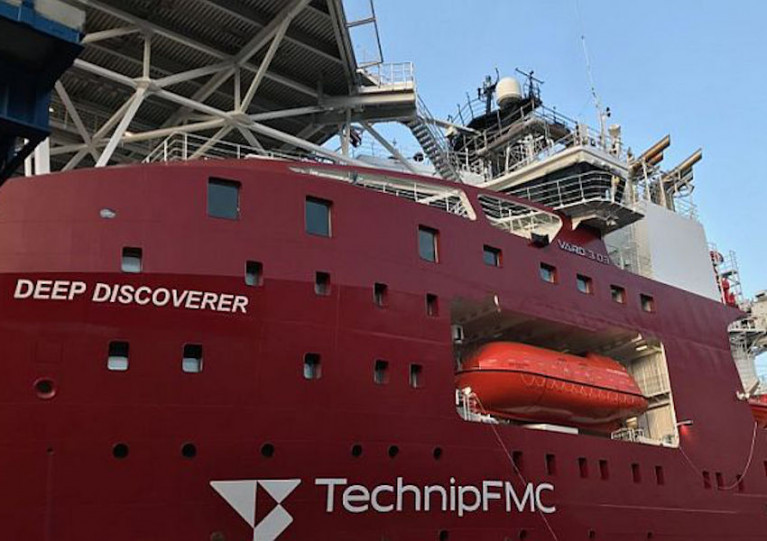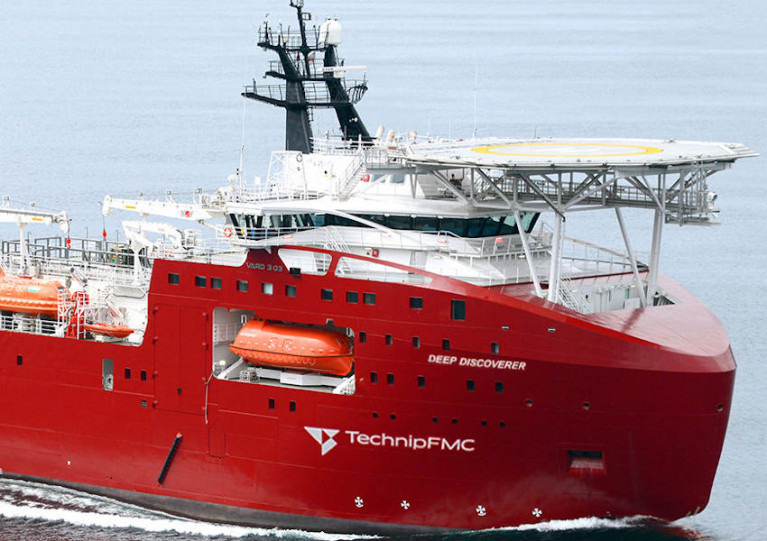Displaying items by tag: Kinsale Energy
The Department of Transport has been advised by PSE Kinsale Energy Limited that rock placement works will take place in the Celtic Sea between this Saturday 10 June and the end of July.
Works will take place at various locations along the routes of decommissioned, but remaining in-situ, pipelines to the Kinsale Head and Seven Heads Gas Fields in the Celtic Sea.
The start date of the works and the estimated duration of 20 days are subject to weather conditions and operational constraints.
Works will be conducted using the vessels Rollingstone (callsign PHYR) and Flintstone (PBZD). Both will operate during day and night hours and will display all appropriate lights and signals.
Within each of the defined work areas, the vessels will be undertaking rock placement works using a fallpipe system and associated acoustic survey works using a multi-beam echosounder.
All other vessels, particularly those engaged in fishing, are requested to give the vessels a wide berth and keep a sharp lookout in the relevant areas. The vessels can be contacted on VHF Channel 13.
Further details including a map, coordinates and contact information can be found in Marine Notice No 34 of 2023, attached below.
PSE Kinsale Energy Limited will be carrying out debris clearance activities in the Celtic Sea from this Thursday 1 June for an estimated duration of 25 days, subject to weather and operational constraints.
The works will take place at locations of previously decommissioned infrastructure on the Kinsale Head and Seven Heads Gas Fields and will be conducted by the construction support vessel Dina Star (callsign LDJG3) using subsea construction equipment.
The Dina Star will operate during day and night hours and will display appropriate lights and signals.
All other vessels, particularly those engaged in fishing, are requested to give the Dina Star a wide berth during the operations and keep a sharp lookout in the relevant areas. The vessel can be contacted on VHF Channel 13.
Coordinates, a map and contact details can be found in Marine Notice No 33 of 2023 attached below.
Marine Notice: Pipeline and Debris Surveys in Celtic Sea at Kinsale Head and Seven Heads Gas Fields
PSE Kinsale Energy Limited will be carrying out pipeline and debris clearance surveys commencing on or around Friday 17 February, weather depending.
The approximately 10 days of surveys will take place along the routes of decommissioned — but remaining in-situ — pipeline routes for the Kinsale Head and Seven Heads Gas Fields in the Celtic Sea and around the locations of removed subsea equipment and wellheads.
A number of surveys will be carried out during the campaign to confirm the status of decommissioned pipelines and umbilicals, which will be left in situ, and to confirm the location of any debris to be removed at the sites of decommissioned subsea facilities.
The surveys will be conducted by the State’s latest research vessel RV Tom Crean (callsign EIYX3), which will operate during day and night hours and will display appropriate lights and signals.
Within each of the defined survey areas, the vessel will be undertaking acoustic survey works using single/multi beam echo sounders and more.
All other vessels, particularly those engaged in fishing, are requested to leave a wide berth during the operations, pass at minimum speed to reduce vessel wash, and keep a sharp lookout in the relevant areas. The vessel can be contacted on VHF Channel 13.
Full details of relevant coordinates, a map of the campaign area and contact information can be found in Marine Notice No 4 of 2023, attached below.
The Department of Transport has been advised that Kinsale Energy plans to undertake decommissioning activities on the subsea infrastructure in the Kinsale Head and Seven Heads gas fields.
These works are due to commence on or around Tuesday 10 May and are estimated to last 20 days, weather depending.
The operation will be conducted by the construction support vessel Skandi Constructor (callsign C6ZH8), which will be on VHF Channel 13.
Works will involve the use of subsea construction equipment on and around the subsea infrastructure, including remotely operated vehicles/equipment.
All vessels operating in its vicinity are requested to keep their distance and pass at minimum speed to reduce vessel wash.
Coordinates of the works areas, contact details and more can be found in Marine Notice No 20 of 2022, attached below.
Well Abandonment Campaign Continues Off South Coast With Rig Move to Ballycotton Gas Field
The latest rig move as part of PSE Kinsale Energy’s subsea well abandonment campaign will take place this week, preceded by anchor pre-lay operations.
The Stena Spey mobile offshore drilling unit (MODU) is currently operating at the Seven Heads Gas Field on well 48/24-5A and will relocate to the Ballycotton Gas Field are — which consists of a single well (48/20-2) — around Wednesday 20 October.
In advance of the move, the eight-anchor mooring spread will be pre-laid at the well location, using the MV Maersk Maker (callsign OZGO2) and MV Maersk Mariner (callsign OWGQ2).
After its arrival in the Ballycotton field, it is anticipated that the rig will continue to operate there until mid-November as a minimum, depending on operational progress.
Following completion of activities in the Ballycotton area, the rig will relocate to Scapa Flow, Orkney in Scotland as this will see all wells abandoned and the campaign completed.
The Stena Spey and its attending vessels will be listening on VHF Channel 16 throughout the operation. All vessels, particularly those engaged in fishing, are requested to give the rig (and pre-laid anchor patterns) a wide berth and to keep a sharp lookout in the relevant areas.
Coordinates of the Stena Spey’s new position at Ballycotton and anchor lays in the are detailed in Marine Notice No 58 of 2021, which can be downloaded below.
Kinsale Energy will undertake vessel-based subsea ROV/removal operations in the Kinsale Head and Seven Heads Gas Fields from later this month.
The works are part of its decommissioning campaign on subsea infrastructure across the two gas fields, and are due to commence on or around Monday 23 August for a period of 20 days, weather permitting.
Works will be conducted from the construction support vessel North Sea Giant (callsign LAYR7) which will be listening on VHF Channel 8.
Details of coordinates of these offshore operations are included in Marine Notice No 46 of 2021, which can be downloaded below.
Drilling Rig Relocation Off South Coast This Week
The latest Marine Notice from the Department of Transport advices of a forthcoming rig move as part of Kinsale Energy’s subsea wells abandonment campaign running until the end of this year.
As previously reported on Afloat.ie, the mobile offshore drilling unit (MODU) Stena Spey (callsign GCWP) will be relocated from the Southwest Kinsale to the Seven Heads gas field this week, in or around Thursday 8 to Saturday 10 July.
Full details of the well locations and related activities are included in Marine Notice No 42 of 2021, which can be downloaded below.
The latest Marine Notice from the Department of Transport advises that Kinsale Energy’s well decommissioning operations at the Kinsale and Seven Heads gas fields will continue in June and July.
The Stena Spey mobile offshore drilling unit (callsign GCWP) is performing the campaign off the South Coast of Ireland with the rig to be positioned at various locations as outlined in Marine Notice No 38 of 2021, which can be downloaded below.
The Stena Spey is currently operating at the Southwest Kinsale Gas Field and will relocate to the Seven Heads Gasfield area in early July.
Pre-lay anchoring activities will get under way later this week (between 10-13 June) prior to the rig relocating to the Seven Heads Gasfield area. These will be conducted by anchor handling vessels MV Maersk Maker (callsign OZGO2) and MV Maersk Mariner (callsign OWGQ2).
Once the Stena Spey is moored at the Seven Heads location, a anchor handling vessel will be chartered to stay with the rig until the end of the campaign. In addition, the rig will retain its permanent standby vessel, the MV VOS Pathfinder (callsign 2ALO7) which will be in the field throughout all operations.
The work vessels will be listening on VHF Channel 16 throughout the operation. All other vessels, particularly those engaged in fishing, are requested to give the rig (and pre-laid anchor patterns) a wide berth and to keep a sharp lookout in the relevant areas.
Coordinates of the anchor positions and other details are included in the Marine Notice attached below.
Diving Operations at Kinsale & Seven Heads Gas Fields
The latest Marine Notice from the Department of Transport advises that Kinsale Energy will undertake diving operations at the Kinsale and Seven Heads Gas Fields for decommissioning on and around the subsea infrastructure.
These works are due to commence on or around Monday 10 May and are estimated to last 25 days, weather depending.
Diver operations will be conducted by the dive support vessel Deep Discoverer (callsign C6EB7) which will be listening on VHF Channel 13, and will take place in the locations listed in Marine Notice No 25 of 2021, which can be downloaded below.
Diving Operations At Kinsale & Seven Heads Gas Fields Next Month
Diving operations will take place at the Kinsale and Seven Heads gas fields early next month for decommissioning work on and around the subsea infrastructure.
Kinsale Energy says the works — undertaken by the dive support vessel Deep Discoverer (callsign C6EB7) — will begin on Friday 2 October and continue for around 30 days, weather depending.
Full details of co-ordinates of the affected areas are included in Marine Notice No 42 of 2020, a PDF of which is attached below.































































